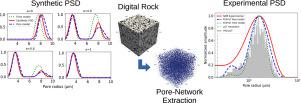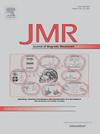多孔介质中孔径分布估计的核磁共振横向弛豫数学模型
IF 1.9
3区 化学
Q3 BIOCHEMICAL RESEARCH METHODS
引用次数: 0
摘要
核磁共振(NMR)是一种广泛应用于多孔介质研究的技术。特别令人感兴趣的是横向弛豫时间(T2),当表面弛豫是主要机制时,它通常与孔径有关。在特定的物理假设下,可以利用T2的分布来推断孔隙尺寸分布(PSD)。然而,在真实的多孔岩石中,扩散和松弛机制的结合使这种解释复杂化。尽管最近在工业应用中取得了进展,但传统模型经常依赖于简化的假设,特别是在考虑快速扩散状态下的孔径时。这导致忽略了横向体松弛(T2B)效应,从而导致孔隙尺寸的低估。为了解决这个问题,数值方法,特别是有限元法(FEM),在对称几何建模方面提供了灵活性,同时显著降低了计算复杂性。本文提出了一个核磁共振数学模型和基于FEM的数值实现,用于模拟PSD的横向磁化信号,并通过半解析解进行了验证,并应用于合成样品和实际样品,如Berea砂岩。此外,引入了拉普拉斯逆变换(ILT)模型中的变量变化来直接估计PSD,证明了实验数据和模拟数据之间的强烈一致性。本文章由计算机程序翻译,如有差异,请以英文原文为准。

A mathematical model of NMR transverse relaxation for pore size distribution estimation in porous media
Nuclear Magnetic Resonance (NMR) is a widely useful technique for studying porous media. Of particular interest are transverse relaxation times (), which are often associated with pore size when surface relaxation is the dominant mechanism. Under specific physical assumptions, a distribution of can be used to infer the pore size distribution (PSD). However, in real porous rocks, a combination of diffusion and relaxation mechanisms complicates this interpretation. Despite recent advancements in industrial applications, conventional models frequently rely on simplifying assumptions, particularly when pore size is considered in the fast diffusion regime. This results in the neglect of transverse bulk relaxation () effects, leading to underestimations of pore sizes. To address this, numerical methods, particularly the Finite Element Method (FEM), offer flexibility in modeling symmetric geometries while significantly reducing computational complexity. This paper presents a mathematical NMR model and numerical implementation based on FEM to simulate transverse magnetization signals for a PSD, validated with semi-analytical solutions and applied to synthetic and real samples, such as Berea sandstone. Additionally, a change of variable in the Inverse Laplace Transform (ILT) model is introduced for the direct PSD estimation, demonstrating a strong agreement between experimental and simulated data.
求助全文
通过发布文献求助,成功后即可免费获取论文全文。
去求助
来源期刊
CiteScore
3.80
自引率
13.60%
发文量
150
审稿时长
69 days
期刊介绍:
The Journal of Magnetic Resonance presents original technical and scientific papers in all aspects of magnetic resonance, including nuclear magnetic resonance spectroscopy (NMR) of solids and liquids, electron spin/paramagnetic resonance (EPR), in vivo magnetic resonance imaging (MRI) and spectroscopy (MRS), nuclear quadrupole resonance (NQR) and magnetic resonance phenomena at nearly zero fields or in combination with optics. The Journal''s main aims include deepening the physical principles underlying all these spectroscopies, publishing significant theoretical and experimental results leading to spectral and spatial progress in these areas, and opening new MR-based applications in chemistry, biology and medicine. The Journal also seeks descriptions of novel apparatuses, new experimental protocols, and new procedures of data analysis and interpretation - including computational and quantum-mechanical methods - capable of advancing MR spectroscopy and imaging.

 求助内容:
求助内容: 应助结果提醒方式:
应助结果提醒方式:


